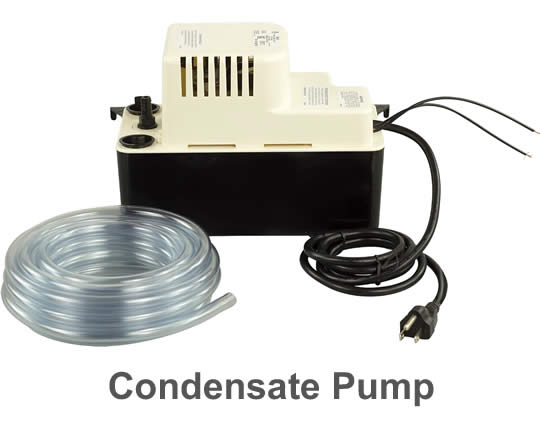How a Condensate Pump Works
Appearing like a small, toy-like item attached to the HVAC central unit, the condensate pump does an important job. How does a condensate pump work and what does it do?
Let's take a look at this curious little addition to a central air conditioning and heating system and see what it is, why it's there and how it works!
What is a Condensate Pump?
 As the name suggests, it is a small water pump that is integrated in the central unit of a building's heating and cooling system.
As the name suggests, it is a small water pump that is integrated in the central unit of a building's heating and cooling system.
The job of this miniature sump pump is to evacuate water out of a container where it collects and send it on its way out of the building to a suitable drainage outlet.
Without it, you'd likely suffer from a wet floor problem from an overflowed tank. During the hot summer months, the result could be excess condensation and a slippery wet floor in the basement or wherever the HVAC unit is situated.
What Condensate Pumps Do
The job this device performs is rather important. It collects and pumps out all the condensed water that gathers inside an HVAC system during the air conditioning processes and also to a lesser extent during heating in winter.
The air conditioning process draws warm, moist air in and passes it across the cooling coils. That moisture condenses on the coils and forms large water droplets that drip into a drain pan, located below.
While there is a type of window or portable self evaporating air conditioner that greatly reduces the amount of condensate that ends up filling a container, most larger central air systems do not include this feature.
Heating System and Moisture
The heating process in action inside a condensing gas furnace also creates condensation. This is how that happens:
The heating system does not dispel combustion gases immediately through vents. Instead, it retains the gases to extract heat from. As that gases cool, the moisture they contain condenses into water that also drips down into the drain pan.
A condensate pump is integrated in the drain pan to collect the condensate produced and disperse them. This is generally because many HVAC units are located in the basement (or, where a basement is not present, the ground floor) of a building, where liquid cannot be drained simply by gravity.
How Condensate Pumps Work
Let's take the example of condensation created in a typical air conditioning system and look at an condensate pump's fairly simple operational process.
As warm, moist air being conditioned passes over the cooling coils, that cooling action creates the formation of condensation on the surface of the coils. The condensate collects and forms large water droplets that drip into a tray that is located below in the unit's air handler or blower unit.
It then flows down into a flexible drain tube or pipe that exits into the unit's water reservoir containing the condensate pump and a float switch.
Float Switch
As more condensate drains into the reservoir, the water level rises until it reaches the top of the tank. The float switch lifts and activates the condensate pump's electric motor.
Now the pump begins the process of evacuating the collected water from the tank through a drain pipe (typically flexible plastic tubing). The condensate line generally leads through an external wall to the outside of the building. In some cases it can instead lead to a floor drain or a utility sink if there is one available.
Pumps with Two-Stage Switches
Some models of condensate pump fall into the two-stage switch category. These provide additional backup to prevent the accumulated condensate from pouring out onto the floor in the event of a blockage or pump failure.
If there is a problem and the water rises above the first stage without the pump being activated, a second switch is engaged. This will either trigger an alarm or shut off the pump or both.
Problems with Condensate Pump
While problems can occur with condensate pumps, they are generally uncommon. Let's look at some possibilities, just in case.
If water appears on the floor around the heating and air conditioning system, this is a sure indication that there is a problem.
It may be that the pump has developed a problem as follows:
- Excessive wear on the motor or float mechanism
- Debris collected on the float and its various components, clogging up the system
- The drain hose is blocked
If the float is unable to move through being blocked, it may fail to trigger the motor to start up. Before replacing the unit with a new one or calling a technician, It is a good idea to refer to the owner's manual where there is sure to be a list of troubleshooting suggestions you can follow to find the fault.
Conclusion
A condensate pump is a relatively simple piece of equipment that does a very important job in central air systems, although it is not generally needed for smaller self contained AC units.
It keeps your floors dry be preventing excess water overflowing from the HVAC unit's water collection reservoir by pumping it out of the building as necessary.
![]()

